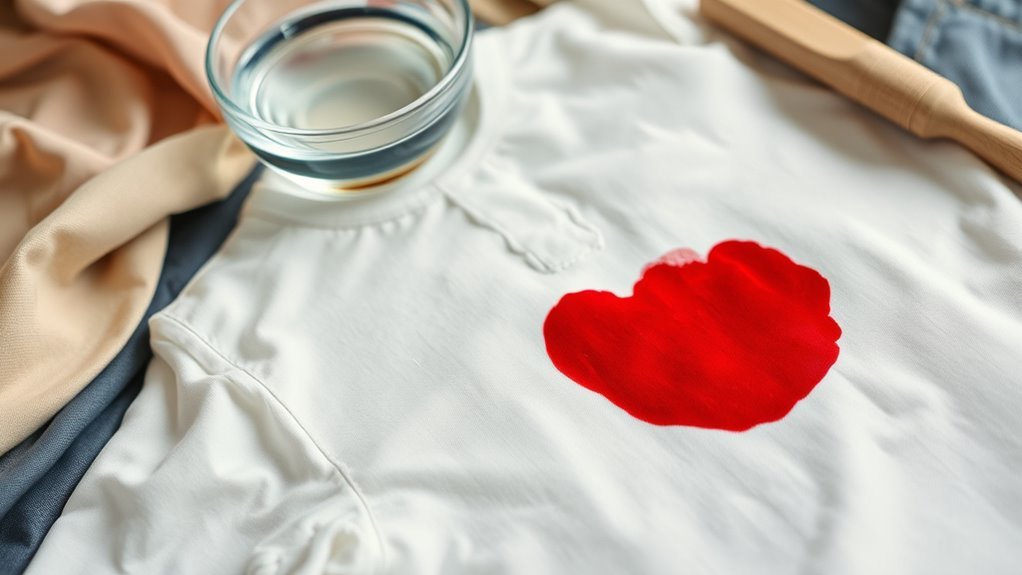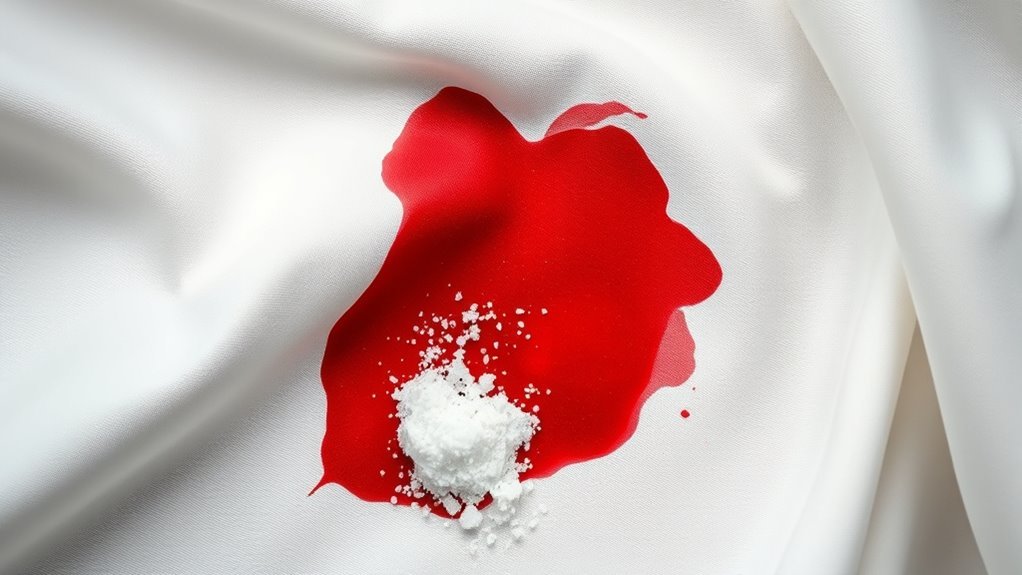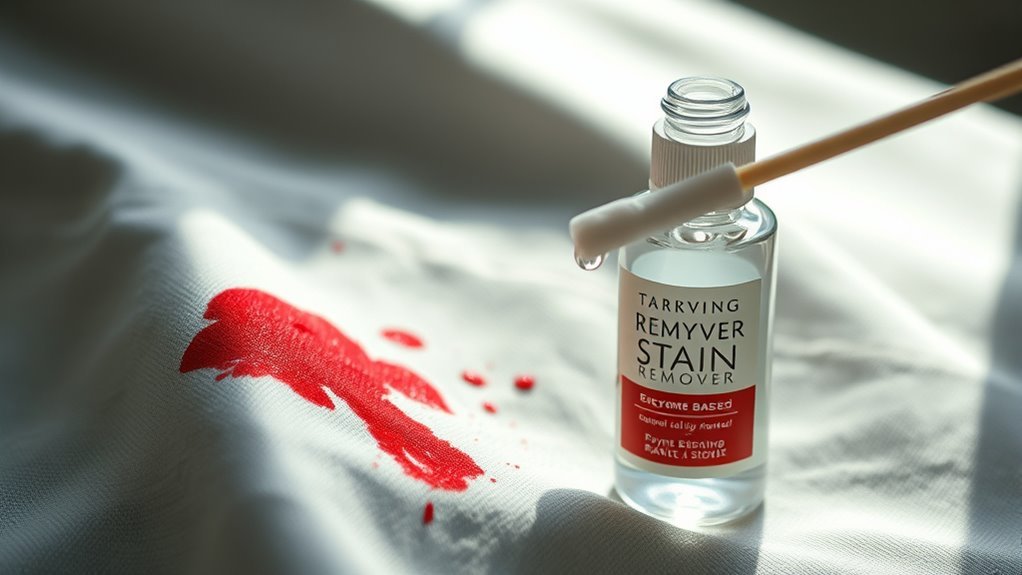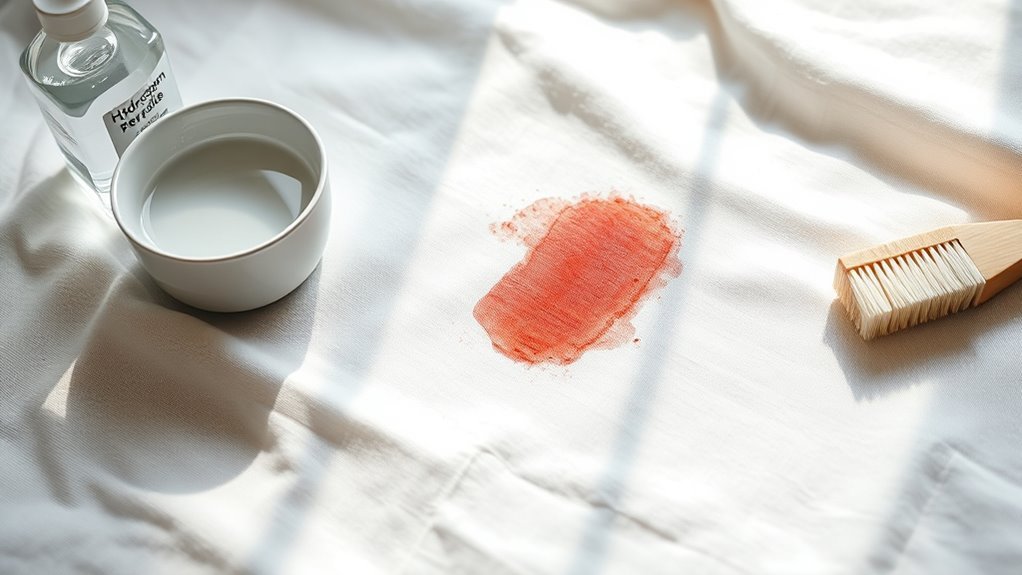How to Tackle Blood Stains on Fabrics
When you get blood on fabric, act fast by blotting with a clean cloth—don’t rub. Rinse immediately with cold water to stop the stain from setting, as warm water can make it permanent. You can sprinkle salt or apply a baking soda paste to pull out the stain before rinsing again. For tough spots, a little hydrogen peroxide helps, but test it first. Follow these simple steps, and you’ll be better equipped to handle stains every time. Keep going to discover more effective methods.
Understanding Blood Stains and Fabric Types

Before you try removing blood stains, it’s important to understand how different fabrics react to blood and cleaning methods. Blood composition includes proteins, enzymes, and iron, which can bind tightly to fibers, making stains tricky. When blood lands on fabric, absorption varies—natural fibers like cotton soak it up quickly, while synthetic fabrics resist it somewhat. Knowing this helps you choose the best approach without damaging your clothes. Since you value freedom in your choices, understanding fabric absorption lets you confidently tackle stains without relying on harsh chemicals or guesswork. Keep in mind, delicate fabrics like silk or wool need gentler care because their fibers absorb and hold blood differently, requiring tailored methods. Grasping these basics sets you free to act smartly and effectively.
Immediate Actions to Take When Blood Spills
When blood spills on your fabric, act quickly to prevent it from setting. Use cold water to rinse the stain gently, and remember to blot instead of rubbing to avoid spreading it. These simple steps can make a big difference in removing blood stains effectively.
Act Quickly
Although blood stains can seem stubborn, you can greatly improve your chances of removing them by acting immediately. When a spill happens, hesitation only lets the stain set deeper, making stain removal tougher and risking damage to your fabric care routine. To seize control and keep your fabrics looking free and fresh, follow these swift steps:
- Gently blot the blood with a clean cloth to absorb as much as possible without rubbing.
- Avoid using heat or harsh chemicals that can set the stain permanently.
- Keep the stained fabric separate to prevent spreading while you prepare for treatment.
Use Cold Water
After you’ve gently blotted up as much blood as possible, the next step is to rinse the stain with cold water. Cold water benefits are real—it helps prevent the blood from setting into the fabric, making removal easier. Don’t fall for cold water myths that say warm or hot water cleans better; heat actually cooks the proteins in blood, locking the stain in place. Using cold water gives you the freedom to act swiftly without damaging your fabric. Just hold the stained area under a cold running tap or soak it briefly. This simple step keeps the blood from bonding with fibers, giving you a better chance at total stain removal later. Embrace cold water—it’s your ally for quick, effective stain control.
Blot, Don’t Rub
Because blood stains can set quickly, you’ll want to blot the area gently instead of rubbing it. Rubbing pushes the stain deeper into the fabric, making it harder to remove and risking damage. Mastering simple blotting techniques gives you control and freedom to handle spills immediately, protecting your clothes effortlessly. When you spot blood on fabric, remember:
- Use a clean, white cloth or paper towel to avoid color transfer.
- Apply gentle pressure; let the cloth absorb the blood rather than scrubbing.
- Repeat blotting with fresh sections of the cloth until no more blood lifts.
This careful fabric care preserves your garments’ integrity and saves you time. By choosing to blot, you’re taking a powerful first step toward stain freedom without harm or hassle.
Using Cold Water to Prevent Stain Setting
You should always use cold water when treating blood stains because it prevents the proteins from setting into the fabric. Applying cold water right after the spill keeps the stain from becoming permanent. Waiting too long or using warm water can make the stain much harder to remove.
Why Cold Water Works
Although it might seem tempting to reach for warm water, using cold water is key when dealing with blood stains. The cold water importance lies in its ability to prevent the blood from setting into the fabric, giving you a better chance to lift the stain without causing fabric damage. Warm water actually cooks the proteins in blood, making stains stubborn and permanent.
Using cold water helps you:
- Keep your fabrics looking fresh and vibrant, preserving your freedom to wear what you love.
- Avoid irreversible fabric damage that limits your choices.
- Take control of stain removal with a gentle, effective approach.
When to Apply Cold Water
If you want to stop blood stains from setting, applying cold water immediately is essential. The cold water benefits are clear: it prevents the protein in blood from binding to fabric fibers, making stains easier to remove. As soon as you notice a fresh blood stain, run the fabric under cold water or soak it right away. Using cold water techniques like gentle rinsing or soaking for 10-15 minutes helps loosen the stain without pushing it deeper. Avoid hot water at this stage—it sets the stain permanently. Acting fast means you maintain freedom from stubborn marks and save time on tough cleaning later. Remember, timing is everything when using cold water techniques to keep your clothes looking fresh and stain-free.
Applying Salt and Baking Soda Treatments

Two common household ingredients, salt and baking soda, can be surprisingly effective at lifting blood stains from fabrics. You’ll want to harness salt absorption first by sprinkling salt generously over the damp stain. This draws out the blood, loosening its grip on the fibers. After letting it sit for about 10 minutes, gently brush off the salt. Next, try baking soda application by mixing baking soda with a little cold water to form a paste. Apply this paste to the stain and let it rest for 30 minutes before rinsing.
- Feel empowered using simple, natural solutions.
- Reclaim your freedom from harsh chemicals.
- Enjoy quick, easy stain removal without stress.
These methods give you control and freedom over your fabrics’ fate.
Utilizing Hydrogen Peroxide for Stubborn Stains
When blood stains won’t budge with salt or baking soda, hydrogen peroxide can be your next best bet. This powerful stain removal agent breaks down blood proteins, making it easier to lift those stubborn marks. You just need to apply a small amount directly onto the stain and let it fizz for a minute or two. Be sure to test it on a hidden area first, as hydrogen peroxide can sometimes bleach delicate fabrics. After it bubbles, gently blot the stain with a clean cloth, then rinse with cold water. Repeat if necessary, but don’t overdo it to protect your fabric’s integrity. With hydrogen peroxide, you reclaim control over tough stains, freeing your clothes from those persistent blood marks quickly and effectively.
How to Use Enzyme-Based Stain Removers

Since blood is primarily made of proteins, enzyme-based stain removers can be especially effective at breaking down and lifting these stains from fabrics. You’ll want to apply the remover directly to the blood stain to activate the enzyme action. This process targets the proteins, promoting thorough stain breakdown and freeing your fabric from stubborn marks.
To make the most of enzyme-based removers:
- Treat stains promptly to enhance enzyme efficiency
- Gently rub the remover in to boost stain breakdown
- Let the product sit for at least 15 minutes before rinsing
Using these removers lets you regain control over your fabrics, freeing you from the frustration of persistent blood stains. Embrace this simple method and enjoy the freedom of fresh, clean clothes.
Washing and Drying Tips for Blood-Stained Fabrics
Although treating the stain is essential, how you wash and dry blood-stained fabrics can make all the difference in preventing the mark from setting permanently. Start with a detergent selection that’s tough on proteins but gentle on your fabric. Enzyme-based detergents often work best for breaking down blood residues. Always check the fabric care label before washing; some materials need cold water to avoid setting stains, while others can handle warm cycles. Avoid hot water initially—it can make the stain permanent. When drying, skip the dryer until you’re sure the stain’s gone; heat can fix blood stains irreversibly. Instead, air dry and inspect. If any trace remains, repeat the process. This approach lets you maintain your fabrics’ freedom from stains without sacrificing their integrity.
Preventive Measures to Avoid Future Blood Stains
Because blood stains can be stubborn and frustrating to remove, taking simple preventive steps can save you time and effort. Embracing preventive laundry habits helps you maintain freedom from stress and ruined clothes. Blood proofing fabrics is a smart strategy to protect your favorite pieces and keep your wardrobe fresh.
Prevent blood stains with simple steps to save time, avoid stress, and keep clothes fresh.
Here’s what you can do:
- Choose fabrics with blood-resistant finishes or treat your clothes with blood-proofing sprays.
- Always keep a stain remover pen or wipes handy for quick action.
- Wear protective layers or aprons during activities where blood exposure is likely.
Frequently Asked Questions
Can Blood Stains Be Removed From Leather or Suede Materials?
Imagine you’ve just spotted a blood stain on your favorite leather jacket. Can it be removed? Yes, with careful leather treatment, you can gently blot the stain using a damp cloth and mild soap, avoiding harsh scrubbing. For suede care, it’s trickier—using a suede eraser or professional cleaner is best to preserve the material’s texture. You’ve got the freedom to restore your gear, just take it slow and treat it right.
Is It Safe to Use Bleach on Blood-Stained Fabrics?
You might be tempted to use bleach on blood-stained fabrics, but it’s not always safe. Bleach can weaken or discolor certain fabric types, especially delicate ones like wool or silk. Instead, try bleach alternatives like hydrogen peroxide or enzymatic cleaners; they’re gentler and effective. Always test a small hidden area first to avoid damage. Choosing the right method gives you freedom to clean without ruining your favorite clothes.
How Do Blood Stain Removal Methods Differ for Colored vs. White Fabrics?
When it comes to blood stains, you don’t want to put the cart before the horse with colored fabrics. You’ve got to be mindful of color fastness—harsh chemicals like bleach can ruin the hue. For whites, you have more freedom to use stronger stain removers without worrying about color loss. Also, avoid hot water at first; it can cause stain setting on both. Treat gently, and you’ll keep your clothes looking fresh and vibrant.
Can Blood Stains Be Removed After the Fabric Has Been Ironed?
If you’ve already ironed blood stains, it’s tougher to remove them because heat can set the stain permanently. Depending on your fabric type, you might have better luck with cold water and enzymatic stain removers, but don’t expect miracles. Using a low iron setting next time helps prevent setting stains accidentally. For freedom from stubborn marks, treat stains before ironing — that way, you keep your clothes fresh and ready for anything.
Are There Any Natural Alternatives to Chemical Stain Removers?
If you’re seeking simple, sustainable solutions, you’ll love natural alternatives! Baking soda brilliantly banishes blood stains, while vinegar solution swiftly softens stubborn spots. You can sprinkle baking soda on damp stains, let it sit, then rinse with cold water. Or dab a vinegar solution on the fabric to break down the blood. These eco-friendly options free you from harsh chemicals, giving you peace of mind and a fresh, clean fabric without compromise.






